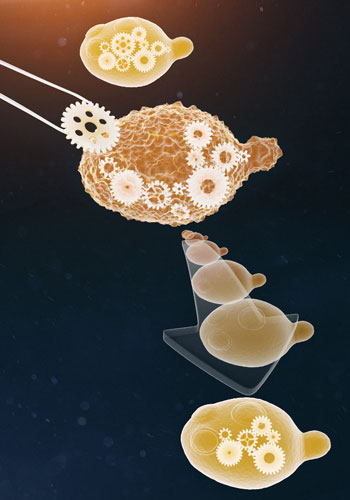Typically biological functions are performed by functional modules, such as the mitotic spindle or the cell polarisation machinery, which are shared between various species and are fundamental to the organisms’ survival. Nevertheless, components that are essential for a module in one species can be absent in the module of an evolutionarily distant relative, even though the modules must perform the same task. In this study we used experimental evolution to ask how a module can diversify to achieve the same function with different components.

Figure: Artist impression of evolutionary adaptation by gene deletions after the removal of an important component in budding yeast. By Andreu Taberner.
The module we investigated induces polarized cell growth in budding yeast. We focused evolution on this module by removing a component (Bem1), critical for this module’s function. After the removal of Bem1, cells proliferated more slowly and polarity establishment was perturbed. We took those sick cells and experimentally evolved them for 1000 generations, at which point the cells had recovered to almost wild-type growth rate. Surprisingly, several independent lines recovered by accumulating mutations in the same three genes, in the same order. And maybe even more surprisingly, all three genes acquired loss of function mutations. Thus the deletion of Bem1 was repaired by inactivating three more genes, instead of mutating a gene to alter the structure of an existing protein to take over Bem1’s role.
Based on our experiments we speculate that diversification of functional modules during natural evolution could start with the loss of an important component, which could lead to the inactivation of other components. If, in parallel, new components are recruited, the combination of loss and gain will diversify the components in a module. In the future we want to investigate how the biochemical and biophysical make-up of a module constrain diversification of its components, and thus, which evolutionary paths are accessible.
Reference
Evolutionary recovery after crippling cell polarization reveals reproducible trajectories. Liedewij Laan, John H. Koschwanez, Andrew W. Murray (2015). eLife, 10.7554/eLife.09638.


































